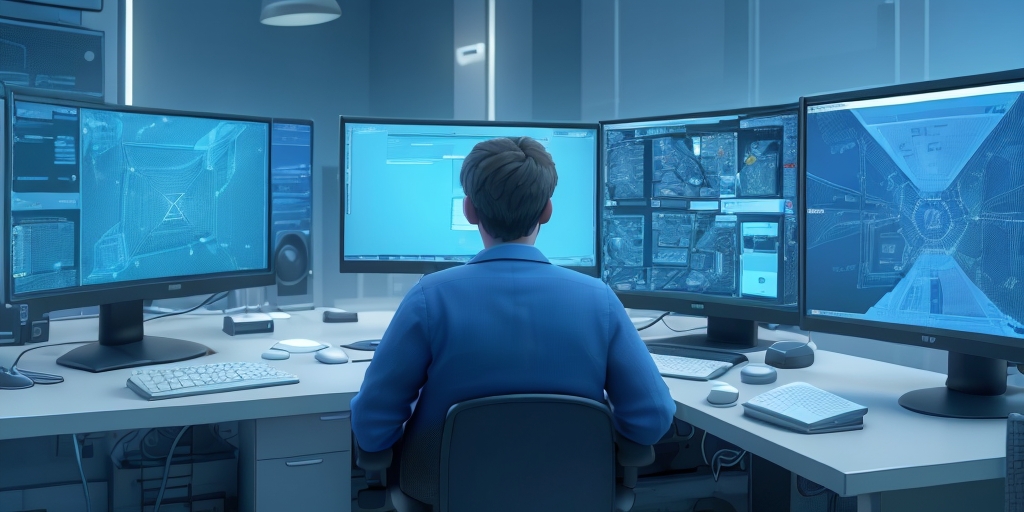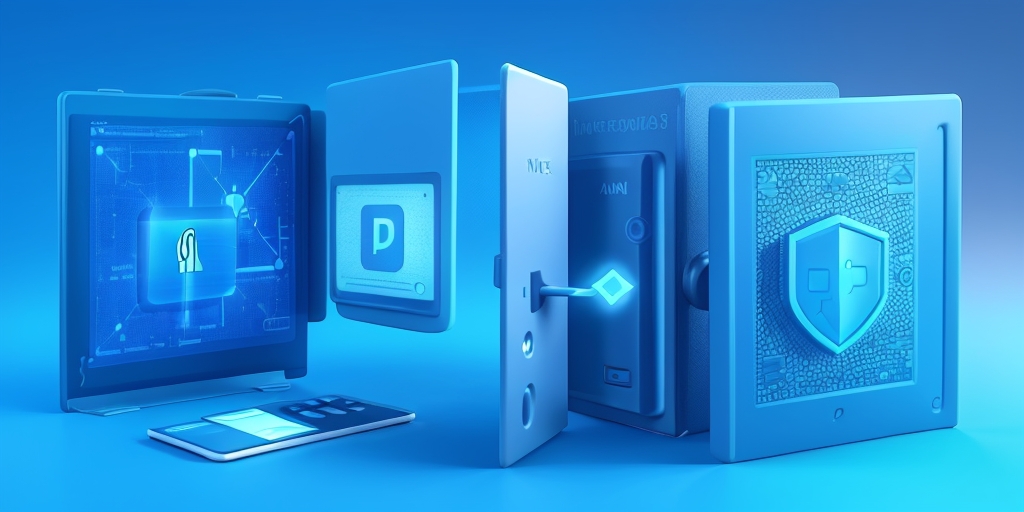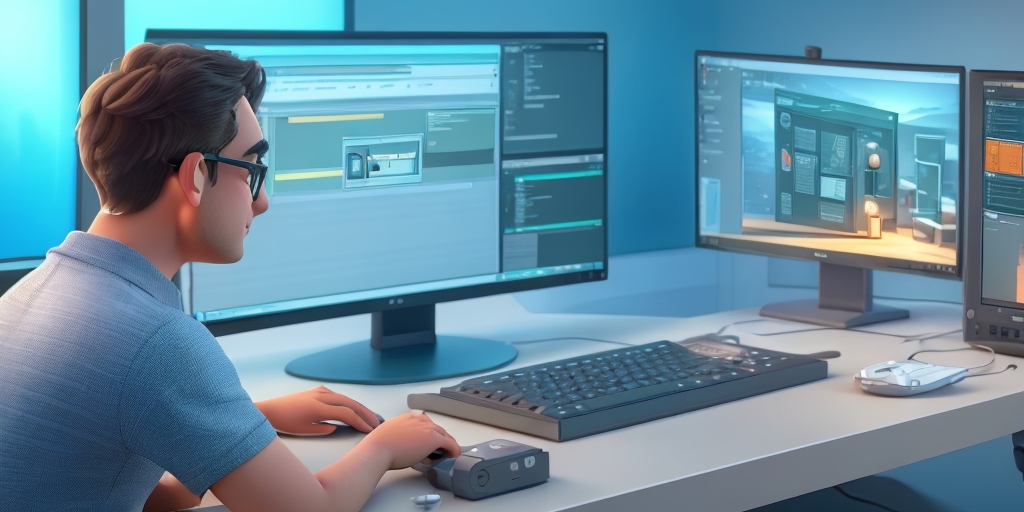Remote Desktop Software: A Closer Look at its Functionality
I am a creative and analytical person who enjoys problem-solving and finding creative solutions. I am driven by curiosity and a passion for learning, and take initiative to explore and understand new concepts. I am a great communicator and collaborate well with others, and am always looking for opportunities to improve myself and my team.
Remote Desktop Software: A Closer Look at its Functionality
Understanding the Basics of Remote Desktop Software

Remote desktop software is a type of application that allows a user to access and control another computer remotely. This is made possible through a protocol known as Remote Desktop Protocol (RDP). RDP is a proprietary protocol developed by Microsoft that allows a user to connect to another computer over a network connection in a secure manner.
Think of it as a digital bridge between two computers. You can sit at your home computer (the local computer), and through the internet, you can access your work computer (the remote computer) as if you were sitting right in front of it. You can open files, run applications, and perform any task you would normally do if you were physically present at the remote computer.
The Purpose of Remote Desktop Software
So, why would someone need to use remote desktop software? Here are a few common uses:
- Remote Access: This is perhaps the most common use. Whether you're working from home and need to access files on your office computer, or you're on a business trip and need to run an application on your home PC, remote desktop software makes it possible.
- IT Support: IT professionals often use remote desktop software to provide support to clients. Instead of physically visiting the client's location, they can troubleshoot and fix issues remotely.
- Collaboration: Remote desktop software can also be used for collaboration. For instance, team members can work on a project simultaneously from different locations.
The Benefits of Using Remote Desktop Software
Using remote desktop software comes with a host of benefits. Here are a few:
- Convenience: With remote desktop software, you can access your computer from anywhere, at any time. All you need is an internet connection.
- Increased Productivity: By allowing employees to work from home or on the go, businesses can boost productivity. A study by Stanford University found that employees who work from home are 13% more productive than those working in an office setting.
- Cost Savings: Businesses can save on costs associated with office space, utilities, and commuting by allowing employees to work remotely.
Now that we've covered the basics of remote desktop software, you might be wondering, "Can remote desktop connections be monitored?" Stay tuned as we delve into this topic in the next section.
Can Remote Desktop Connections Be Monitored?

One of the most common questions that arise when discussing remote desktop software is whether these connections can be monitored. The short answer is yes, they can. But how does this work? Let's break it down.
The Role of Monitoring in Remote Desktop Connections
Monitoring plays a crucial role in remote desktop connections, primarily for security and management purposes. It's like having a security camera in a physical office - it helps keep an eye on activities and ensures everything is running smoothly.
For instance, if you're a business owner with employees accessing company resources remotely, you'd want to ensure they're not accessing sensitive data they shouldn't be. Monitoring can also help identify any potential security threats, like unauthorized access or suspicious activities.
As the famous cybersecurity expert Bruce Schneier once said, "Security is not a product, but a process." Monitoring is a part of this process, helping to maintain the integrity and security of remote desktop connections.
A Tool that can Monitor Remote Desktop Connections
- Splashtop: Besides offering remote access, Splashtop also provides robust activity logging and session recording features.
This tool can not only provide visibility into remote desktop activities but also offer features like alerts for unusual activity, helping to enhance security.
Now that we've covered the monitoring aspect of remote desktop software, you might be wondering about the different types of software available and their features. Well, stay tuned because that's exactly what we're going to explore next. What makes AnyDesk stand out from the crowd? And how does Google's Remote Desktop fare in comparison? Keep reading to find out!
Exploring Different Remote Desktop Software
With the rise of remote work, the demand for efficient and reliable remote desktop software has skyrocketed. But with so many options available, how do you choose the one that's right for you? Let's take a closer look at some of the most popular remote desktop software options and their features.
AnyDesk Review
First on our list is AnyDesk. This software is known for its speed and reliability, making it a favorite among many remote workers. Here are some of its key features:
- High-speed data transmission: AnyDesk uses DeskRT, a codec specifically designed to provide a high frame rate and low latency, even with high screen resolutions or bandwidths of just 100 kB/s.
- Security: AnyDesk uses banking-standard TLS 1.2 technology to protect your computer from unauthorized access.
- Flexibility: AnyDesk works across multiple platforms and operating systems, including Windows, macOS, iOS, Android, Linux, FreeBSD, and Raspberry Pi.
As Steve Jobs once said, "Innovation distinguishes between a leader and a follower." AnyDesk is a clear leader in the remote desktop software market, thanks to its innovative features and user-friendly interface.
Google Remote Desktop Review
Next up is Google Remote Desktop. As part of the Google ecosystem, this software offers seamless integration with other Google services. Here's what you can expect:
- Easy setup: Google Remote Desktop is easy to set up and use. All you need is a Google account, and you can access your computer from any device with a web browser.
- Secure connection: Google uses Chrome's secure sockets layer (SSL) to protect your data.
- Free: Unlike many other remote desktop software options, Google Remote Desktop is completely free.
Google Remote Desktop is a great option for those who are already using Google services and want a simple, secure, and free remote desktop solution.
Choosing the right remote desktop software can significantly impact your productivity and work experience. But the question remains: how do you know which one is the best fit for your specific needs? Stay tuned as we delve deeper into another popular remote desktop software, LogMeIn, in the next section.
LogMeIn: A Closer Look
When it comes to remote desktop software, LogMeIn is a name that often comes up. It's a widely used tool that has gained popularity for its robust features and user-friendly interface. But what exactly makes it stand out? Let's take a closer look.
Features of LogMeIn
LogMeIn is packed with features that make remote access a breeze. Here are some of the key features that make it a popular choice:
- Remote Control: LogMeIn allows you to control your computer from anywhere, as if you were sitting right in front of it. This includes accessing files, applications, and even the full desktop.
- File Transfer: Need to move files between your remote and local computer? LogMeIn makes it easy with its seamless file transfer feature.
- Multi-Monitor Display: If you're working with multiple monitors, LogMeIn has you covered. You can easily switch between screens during a remote session.
- Whiteboard: Collaborate more effectively with the whiteboard feature. It allows you to draw, highlight, and point out areas directly on the screen.
These features, along with many others, make LogMeIn a versatile tool for remote access. As Steve Jobs once said, "Innovation distinguishes between a leader and a follower." LogMeIn is certainly leading the way with its innovative features.
User Experience with LogMeIn
But what do users have to say about LogMeIn? Let's take a look at some user feedback and reviews.
Many users praise LogMeIn for its ease of use. The interface is intuitive, making it easy for even non-tech savvy individuals to navigate. The setup process is also straightforward, allowing users to get up and running quickly.
Users also appreciate the reliability of LogMeIn. It provides a stable connection, ensuring that remote sessions run smoothly without interruptions. This is crucial for businesses that rely on remote access for their daily operations.
However, like any software, LogMeIn is not without its criticisms. Some users have mentioned that the pricing can be a bit steep, especially for small businesses. But many agree that the features and reliability make it worth the investment.
So, is LogMeIn the right remote desktop software for you? It certainly has a lot to offer, but the final decision will depend on your specific needs and budget. But don't worry, we're not done yet. In the next section, we'll provide some tips and best practices for using remote desktop software effectively. Stay tuned!
Making the Most of Remote Desktop Software

So, you've got your remote desktop software installed and ready to go. But how can you ensure you're getting the most out of it? Let's explore some best practices and tips to optimize your remote desktop experience.
Ensuring Security with Remote Desktop Software
First and foremost, security should be your top priority. Remote desktop software, while incredibly useful, can also be a potential gateway for cyber threats if not properly secured. But don't worry, there are several steps you can take to keep your remote desktop connections safe.
Start by setting strong, unique passwords for your remote desktop software. Avoid using easily guessable passwords like '123456' or 'password'. Instead, opt for a mix of letters, numbers, and special characters. Some remote desktop software even offers two-factor authentication for added security.
Next, consider using a firewall. A firewall can help protect your computer by blocking unauthorized access while permitting outward communication. Most operating systems come with a built-in firewall, so make sure it's turned on and properly configured.
Lastly, keep your remote desktop software up-to-date. Software updates often include security patches that fix vulnerabilities, so it's crucial to install them as soon as they're available.
Optimizing Performance with Remote Desktop Software
Now that we've covered security, let's talk about performance. After all, a secure remote desktop connection isn't much use if it's slow or unreliable. Here are some tips to help you get the best performance out of your remote desktop software.
First, check your internet connection. A stable, high-speed internet connection is essential for a smooth remote desktop experience. If you're experiencing lag or disconnections, it might be worth upgrading your internet plan or investing in a better router.
Next, adjust your settings. Most remote desktop software allows you to tweak various settings to improve performance. For example, you might be able to reduce the display quality or disable certain features to save bandwidth.
Finally, consider your hardware. While remote desktop software doesn't typically require a powerful computer, having a decent processor and enough RAM can help ensure a smoother experience, especially if you're running resource-intensive applications remotely.
So, are you ready to make the most of your remote desktop software? Remember, security and performance go hand in hand. By following these tips, you can enjoy a secure, efficient remote desktop experience. But what does the future hold for remote desktop software? Stay tuned to find out.
The Future of Remote Desktop Software

As we look ahead, the future of remote desktop software appears to be bright and full of potential. With the rapid advancements in technology, we can expect to see significant developments and improvements in this field. But what exactly might these changes look like?
Emerging Trends in Remote Desktop Software
One of the most notable trends in the world of remote desktop software is the increased integration with other software and services. For instance, many remote desktop applications are now offering seamless integration with cloud storage services, allowing users to easily access and manage their files from any location. This not only enhances the user experience but also boosts productivity.
Another emerging trend is the use of artificial intelligence (AI) in remote desktop software. AI can help automate routine tasks, provide predictive analytics, and even enhance security measures. For example, AI can detect unusual activity that may indicate a security breach and alert the user or system administrator.
The Impact of Remote Work on Remote Desktop Software
The rise of remote work has had a profound impact on the use and development of remote desktop software. With more people working from home or other remote locations, the demand for reliable and efficient remote desktop solutions has skyrocketed.
A study by Global Workplace Analytics estimates that 25-30% of the workforce will be working from home multiple days a week by the end of 2021. This shift towards remote work is likely to continue driving innovation in remote desktop software, with developers striving to meet the evolving needs of remote workers.
Wrapping Up: The Power of Remote Desktop Software
In conclusion, remote desktop software has come a long way since its inception. It has transformed the way we work, enabling us to access our desktops from anywhere, at any time. The benefits are clear: increased productivity, convenience, and flexibility.
As we look to the future, we can expect to see even more exciting developments in this field. From increased integration with other software and services to the use of AI, the potential of remote desktop software is vast. And with the rise of remote work, the importance of this technology is only set to increase.
So, whether you're a business owner, an IT professional, or a remote worker, it's worth keeping an eye on the future of remote desktop software. It's a powerful tool that's shaping the future of work.



.jpg)
.jpg_nowm_640.jpg)

.jpg)
.jpg)